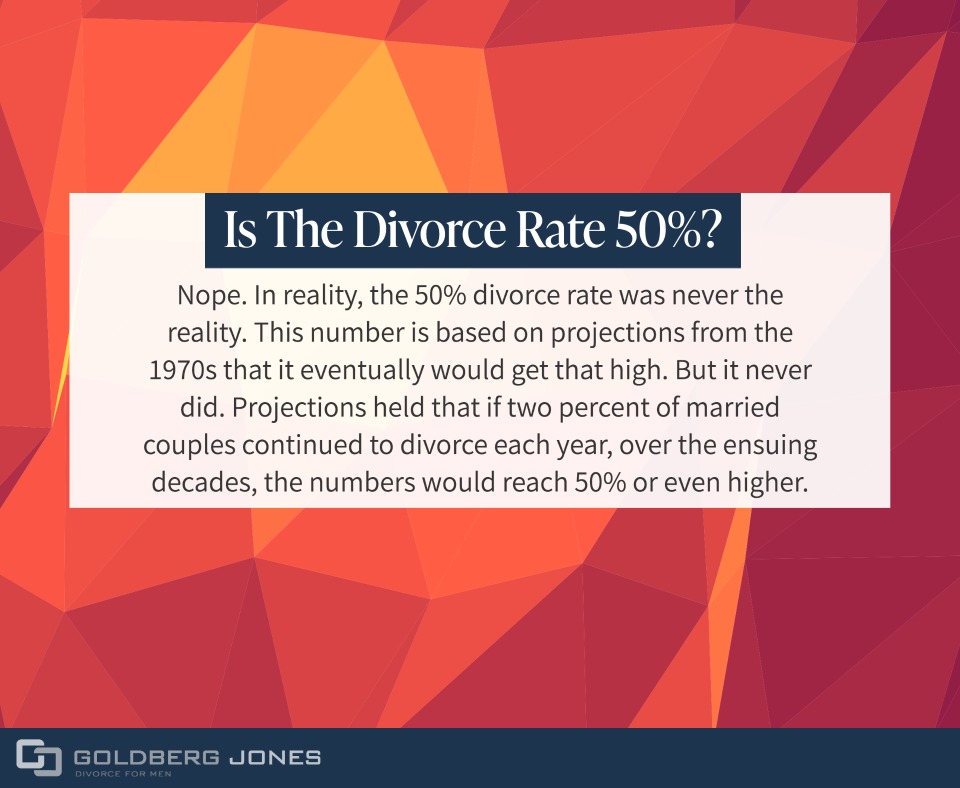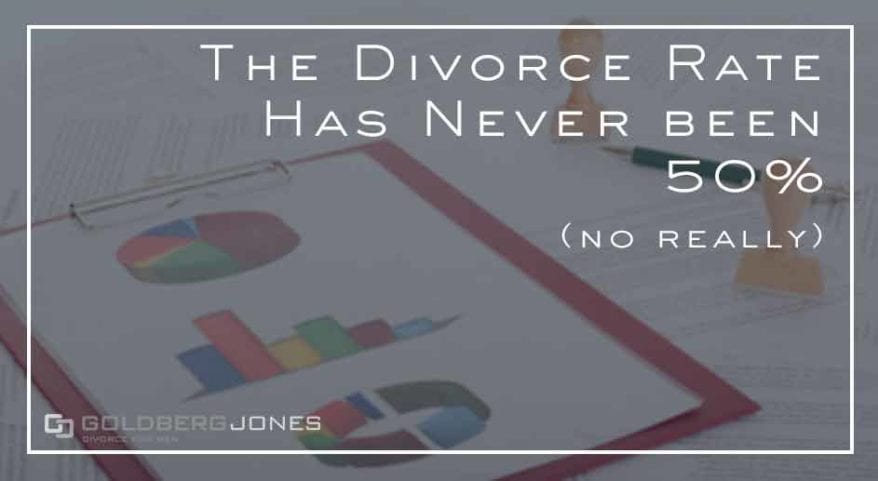One statistic tossed around frequently is that 50% of all marriages end in divorce. The number varies a bit, but the gist is that roughly half of weddings have a corresponding divorce waiting. As ubiquitous as this figure is, many just accept it as fact. But is the legend of the 50% divorce rate real or a myth?
Has the Divorce Rate Ever Been 50%?
So, has the divorce rate ever been 50%?
Nope. Never was. Despite the fact that many hold this wisdom as truth, experts have debunked this figure multiple times over the years.
But if the 50% divorce rate is a myth, the question remains, how did it get started? How did it become so widely agreed upon and acknowledged?

How The 50% Divorce Rate Myth Began
It began in the Baby Boomer generation when people born in the post-World War II years began to marry and start families.
In reality, the 50% divorce rate was never the reality. This number is based on projections from the 1970s that it eventually would get that high. But it never did.
Projections held that if two percent of them continued to divorce each year, over the ensuing decades, the numbers would reach 50% or even higher.
The number itself was never a static amount or representative of current marriages. The projections simply suggested it could get that high if this one trend continued.
It’s information that was widely misinterpreted and misquoted. Over time, it was shared so often, with such an air of authority, we collectively stopped questioning it.
The Divorce Rate Is Actually Dropping
The divorce rate did spike in the 1970s and early ’80s, especially after no-fault divorce became the law in most states.
Under these regulations, neither party has to prove the other is at fault to dissolve a marriage. Instead of blaming one another to determine who is responsible, the only qualifier is that if one party wants a divorce, they can divorce.
Though there was an initial upswing in the dissolution of marriage, the divorce rate has declined steadily since.
Leaving out unions where one spouse died, approximately 70% of marriages in the 1990s made it until their 15th anniversary. This is up from around 65% in the ‘70s and ‘80s.
Moving into the 2000’s, the divorce rate was even lower.
A number of factors contribute to the waning divorce rate:
- People wait until later in life to marry and have children.
- Long-term, non-marital relationships grew more common.
- Cohabitation before marriage became more conventional.
- Expectations of what marriage is and what people want and expect out of it changed.
Unlike many previous generations, marriage isn’t a given.
People aren’t in as great a hurry to get hitched and settle down, and many marriages are less rushed. These days, people often push off tying the knot and take their time to get it right.
Essentially, if people are going to go through the effort of marriage, many want to make sure it sticks. And the divorce rate appears to reflect these trends.
Related Reading: Breaking Down Rates Divorce By Generation
Divorce Rate Statistics
While the divorce rate, as a whole, has been in steady decline, that’s not consistent across every demographic and population.
Factors like education level and race are big indicators of a potential divorce. The Washington Post published the following data based on a 2014 survey:
Related Reading: Odd Divorce Laws From Around the World
Education And Its Effect
According to these numbers, 39% of men with a high school education or below will divorce in their lifetimes. The same is true of 37% of women.
With a college education, the divorce rate drops substantially, to 28% for men and 29% for women. Those numbers hold fairly steady for advanced degrees, landing at 26% for men and 30% for women.
Related Reading: Is January Really Divorce Month?
Race And Divorce
The divorce rate fluctuates wildly across racial boundaries:
- 36% of white men and 38% of white women will dissolve a marriage.
- Those numbers are slightly higher for Black men and women, who both clocked in at 42%.
- Hispanic men and women are less likely to divorce, at 27% for men and 30% for women.
- Members of Asian communities are least likely to divorce, with just 16% of men and 18% of women ending marriages.
- Native American population is the most likely, with 44% of men and 45% of women ending a union.
As you can tell, there are a ton of statistics floating around about divorce and the divorce rate. If you look hard enough, you can find numbers about how almost any factor you can think of impacts marriage and marital happiness.
There are big ones like race, economics, and views on children. But there’s also data on cigarette consumption and what role your Facebook relationship status plays in the likelihood of divorce.
While these statistics provide a broad-spectrum, big-picture look at the divorce rate, every individual situation is different. There’s a great deal of crossover from one group to the next.
Just because you fit into one category or another, doesn’t mean your marriage is doomed. And just because it’s been said many times, doesn’t mean 50% of marriages end in divorce.
Related Reading: Breaking Down Rates Divorce By Generation
